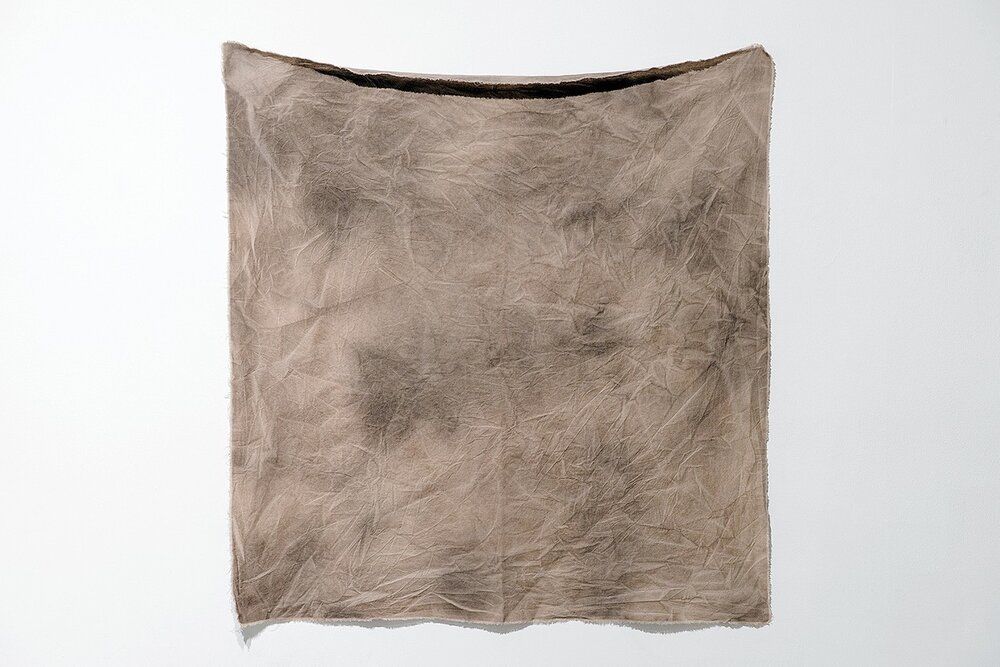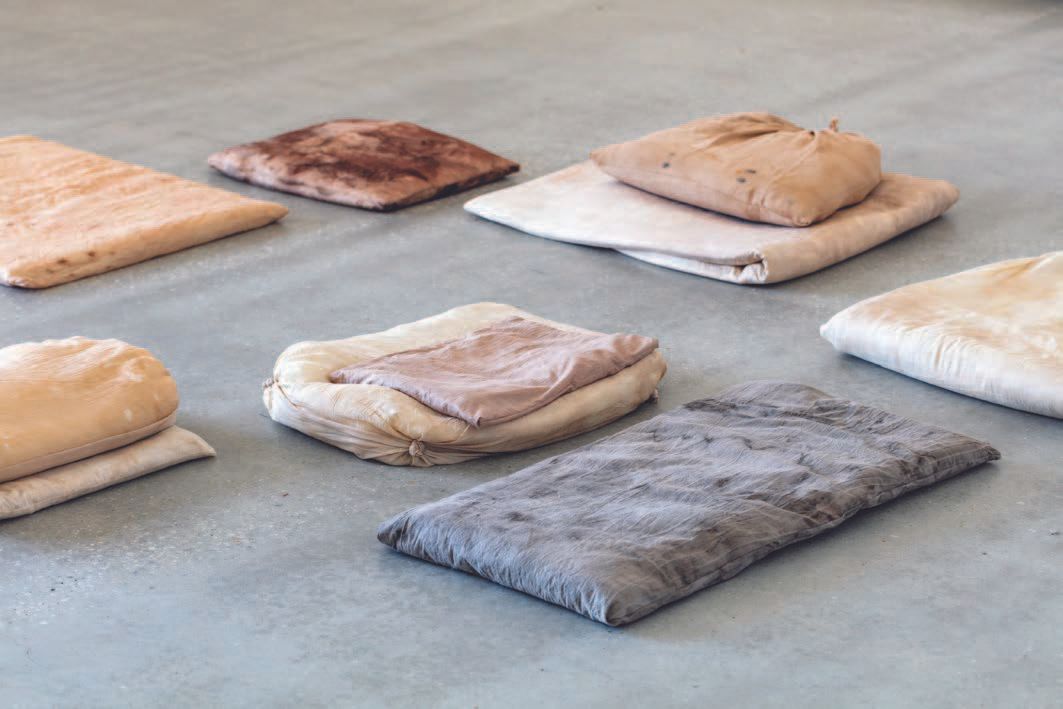Working with Weeds Interview #2
Anna Dunnill
These Works Have No Edges: Artist Katie West on paying attention to plants.

In the work of Yindjibarndi artist Katie West, plants are a connection to place. Now living in the small town of York in Western Australia, West uses the gentle acts of dyeing textiles with plants—walking, looking, gathering, bundling, steeping—to bring attention to the complex and often fragile ecologies that we are all part of. Her work also challenges colonial notions of demarcating spatial borders: for West, a cloth dyed with plants from a particular area is a direct continuation of that Country, whether the plants used are endemic to that area or not. “These works have no edges,” she says. I spoke with West about balancing sustainability in her practice, the garden as a site of Indigenous agriculture, and making string.
Anna Dunnill: Your practice frequently uses plants that reflect a particular place. Are they usually native or endemic to that place?
Katie West: The plants I use are totally dependent on what’s growing where I happen to be living. I do try to focus on native plants, but you get all sorts of things growing in the one place. And actually a lot of the time, using endemic species doesn’t feel right, because their range might not be what it was, so you don’t really want to disturb that. The other part is that for the dyestuff, I collect what’s already fallen to the ground, so not picking—unless it’s a plant that you can see is going to be hacked back at some point.

AD: So not wanting to disturb the surrounding ecosystem, and taking care of the plant within that practice.
KW: Yeah. There’s a couple of things that have come up recently—I have been feeling funny about the bundle dye process. It’s starting to feel quite extractive, especially when often there’s a bit of a push to output larger objects. So I’m sort of reworking that, making sure that it’s still sustainable and not taking up so much space.
AD: Extractive in terms of using up a lot of plant material?
KW: Yeah, using a bit too much plant material. And also, if I had it my way, I would just be doing it when I happen to be going camping somewhere and have a fire and just have the right setup. So that’s occasionally—whereas when it becomes part of a practice that you’re starting to make a living out of, you’re asked to do it more. [I’m trying to] find some middle ground and be more strategic about the plants I use. In my individual practice, it has been totally by chance and what’s been blown down to the ground, really determined by a path of walking through a place.
AD: Are you moving away from bundle dyeing?
KW: Yeah—I just want to try different things. With the bundle dye there is a push to work with a bigger piece of fabric each time you do it, but actually I would much rather be working with smaller pieces. I’m going to try and insist on that. The other part I really love about it is the actual sash of material that I use to tie it tightly. I often find that far more interesting—and you can turn that into rope and work with that. That’s a part I really want to get into as well.

AD: We once had a conversation about identifying plants that might be native to Australia, but not necessarily endemic to a particular place. Is that something that you think about when you’re choosing what to work with?
KW: Yes, but I think in the past I worried about that a bit more. And honestly that had so much to do with authenticity stuff; like colonial ideas of Indigenousness in lots of different ways, [in terms of] people and plants. So I really had to just get rid of that and go with the whole walking and collecting thing: whatever I come across is a valid thing to use, because I’m collecting it.
AD: For me, the reason that I’ve turned towards using weeds in textiles was feeling that if I’m using endemic plants, I need to be really careful about where I’m gathering them, being aware of fragile ecosystems—whereas if I’m picking weeds, that’s less of an issue. But then in a sense I’m privileging these colonial introduced species, when there’s so much potential in native plants…
KW: Yeah. That’s the thing I’ve been tussling with actually. I’ve thought about using things like Paterson’s Curse—I grew up on a wheat-and-sheep farm turned silver perch aquaculture enterprise, and we would have to go around the boundary of our farm just before Paterson’s Curse flowered and pull it all out. So our farm is surrounded by purple—but we’re fine. That had such a big impact on me, that whole process, because it’s one plant, one by one, for the whole boundary.
And like you said—using the weeds, you do feel like you’re giving these colonial plants more air time. But then I do feel like if you’re doing that, then you’re letting the native plants just do their work.

AD: And maybe their work isn’t necessarily the the things that I want them to do—or the dye colours that I want to achieve!
You’ve made work about colonial measures of space—the square metre, for example, in Warna (ground) and One square metre. Do you relate that to how plants and weeds are separated and designated?
KW: In the bigger picture of my practice, the big thing that I’ve had to work on, in a cognitive sense, is that Western or the Anglo thing seems to want to have clear-cut endings, boundaries and categories. That’s what makes the Stolen Generations thing really violent. There is a narrative that purports that if you’re taken away then you’re cut off from culture, and that damage is final—in that story there’s no room for growth or change.
In terms of my connection to my Country—which I’ve never lived on—I understand myself as being connected because I wouldn’t exist if it wasn’t for that Country! And now I take that to other places my ancestors that have lived, non-Indigenous as well.
I’m thinking about a work at the moment—[it’s for an exhibition] about Indigenous agriculture and land management, but I’ve found it really hard to find my place in that. But I’m starting to learn how to make string. I’m doing so partly through an older woman who lives in Roebourne [on the north-west coast of Western Australia]—she sent me back to Perth with a tube of yalhirri, which is a stiffleaf sedge, and showed me how to make string from that.

KW (cont.) I’m also doing a residency with Durrmu Arts and Regina Wilson who’s up in Peppimenarti [an independent Aboriginal community located 300km southwest of Darwin], and also Fayen D’Evie who I work with in Museum Incognita. Regina is just an incredible weaver, and she’s the one who first taught me how to do the rolling technique with the string.
Where I’m living at the moment—and where I’m probably always going to be living, in terms of little towns or urban settings—the land I’m going to have access to, to grow native foods or medicines, is going to be my garden. So I’m starting to think about that as a site for Indigenous agriculture. And maybe it’s not going to be the same [as it was in the past]—though I would like to do some burning; I can imagine having a little grove of weaving grasses and burning that when it’s the right time to do that, for the regrowth and that sort of thing. And using as much as possible the plant foods and medicines from that area—and just incorporating whatever else is interesting from the continent as well. And kind of beyond too, because we’ve got access to so many plants from all over the world.
I’m getting to a point where there’s not this idea that’s causing things to be off limits. Just being much more diverse in what’s possible: in practicing, or just in being myself, thinking about what I want to pass on to the coming generations in our family.
AD: Why do you think it was tricky for you to find your place in the show about Indigenous agriculture, or within those ideas?
KW: Probably partly because of some of the other artists who are in it, who’ve been researching for a long time on this particular area. But I guess—my idea of agriculture or self sufficiency is actually doing the work of growing food and plant medicines and consuming them. And I haven’t been in that position yet. It’s just that fact of living in rentals and never knowing when to start the veggie garden or not. It really is that!
AD: Yeah, I definitely relate to that—wanting to grow stuff but being like, “will I be living here in six months?” There’s something significant about that precarity of living—it feels worth making that evident.
KW: Definitely.
AD: Tell me about learning to make string.
KW: There’s a few different lessons I’ve had about making string. Bigali, who gave me the yalhirri, she’s got a way [of making it]; I’m not going to say how she does it exactly. And I’ve been shown another way when I was a kid—strangely, on a tour at New Norcia [a former Aboriginal mission in regional WA]—a Noongar fella showed us how to make rope with a box reed. I haven’t come across [that reed] again, but it must be around. You get two sticks and pull the reed through, and that breaks it down. Because of the angles of the box reed it works really well, so you get those finer strands and then you’re doing the twisting to make rope. I use that twisting [technique] all the time.
I’ve had a little go with the yalhirri of doing the pulling thing [to break it down], but I think there’s a different process for that. I guess there’s just a lot more experiments to do. I’ve been focusing on the hand stuff, but Yindjibarndi also have these drop spindles, so trying to make and use that.
AD: I’ve been reading a book called Women’s Work: The First 20,000 Years, by Elizabeth Wayland Barber, and the author talks about this idea of the String Revolution—this moment around 35,000 years ago when people discovered how to make string by twisting fibre, and that sparked all these other technologies. We refer to the Stone Age and the Iron Age and the Bronze Age, because those are the bits that we’ve found, but maybe string is even more important.
KW: Recently I’ve been thinking about how human bodies are so geared to making string. And also the idea that the earth is a planet that makes string. A big idea, but—it just makes you feel nice.

Working with Weeds is an interview series developed during a Blindside ‘Isolation Residency’ in August 2020. As a public outcome of the residency, this interview project is facilitated and supported by Blindside through funding from City of Melbourne.
This project was undertaken on the lands of the Wurundjeri and Boon Wurrung peoples, who have never ceded sovereignty. I pay respect to Elders past and present, and particularly acknowledge the Wurundjeri Willam people who have maintained and farmed the Merri Creek area since time immemorial. I honour their deep and living knowledge of its plants, animals and seasonal cycles. As an occupier I strive to live respectfully and in a spirit of collaboration with this place.
Always was, always will be Aboriginal land.
Working with Weeds is an interview series developed during a Blindside ‘Isolation Residency’ in August 2020. As a public outcome of the residency, this interview project is facilitated and supported by Blindside through funding from City of Melbourne.
Text by Anna Dunnill, November 2020